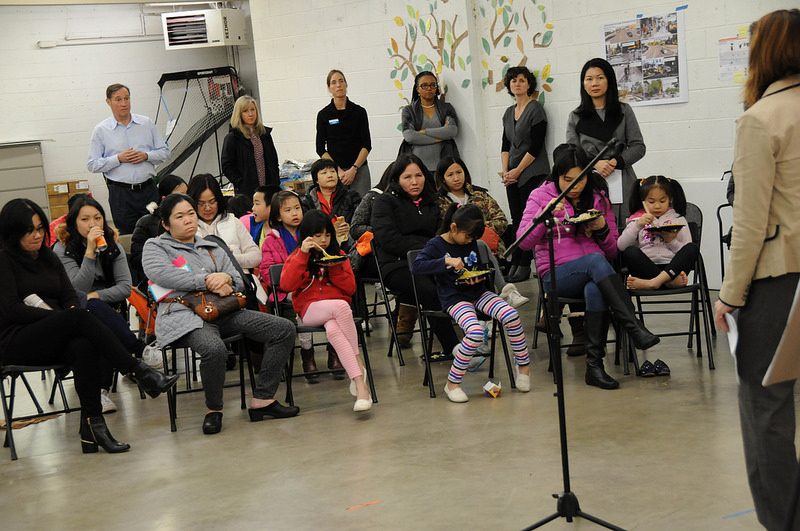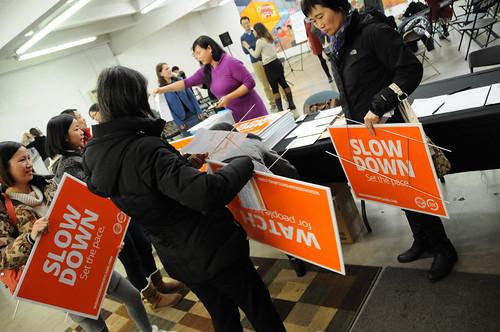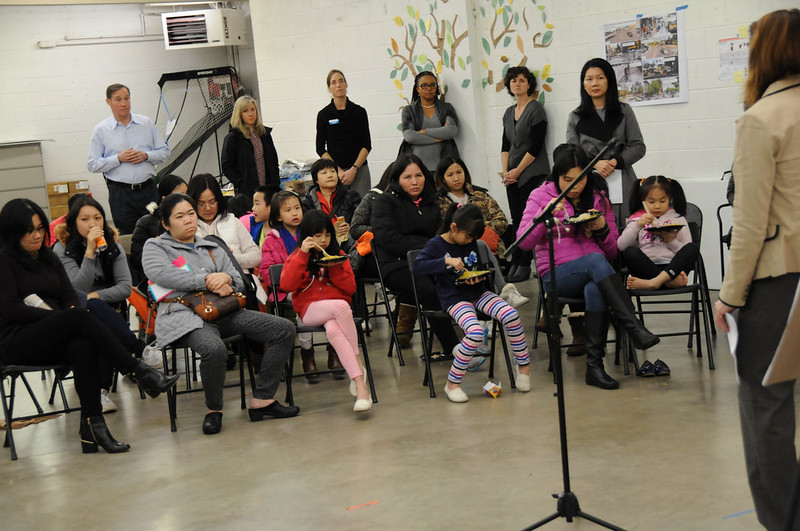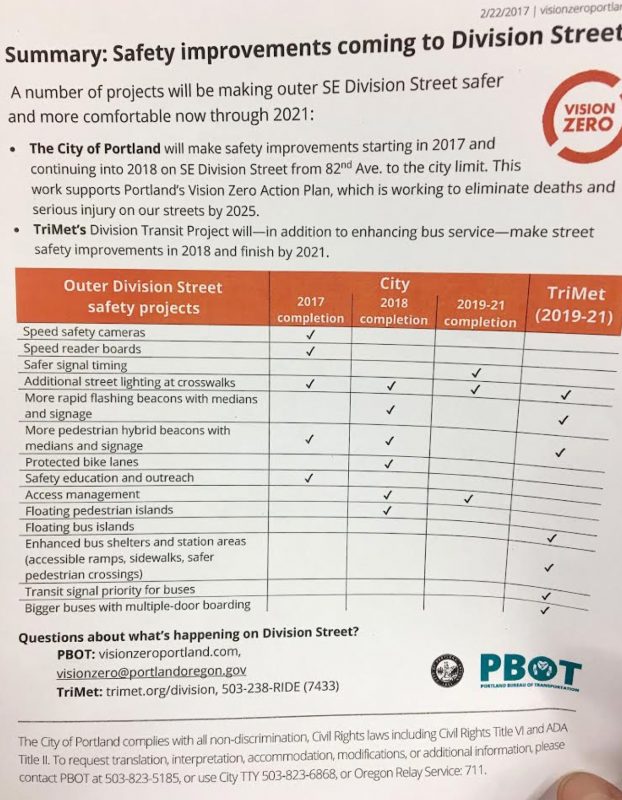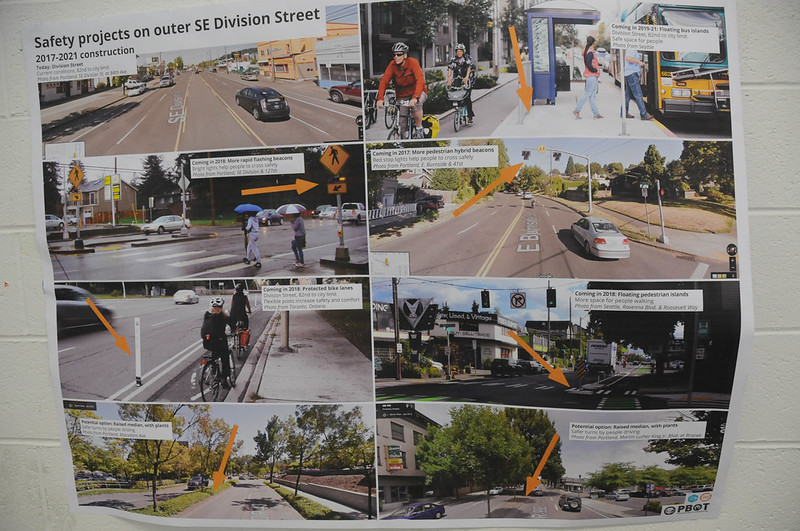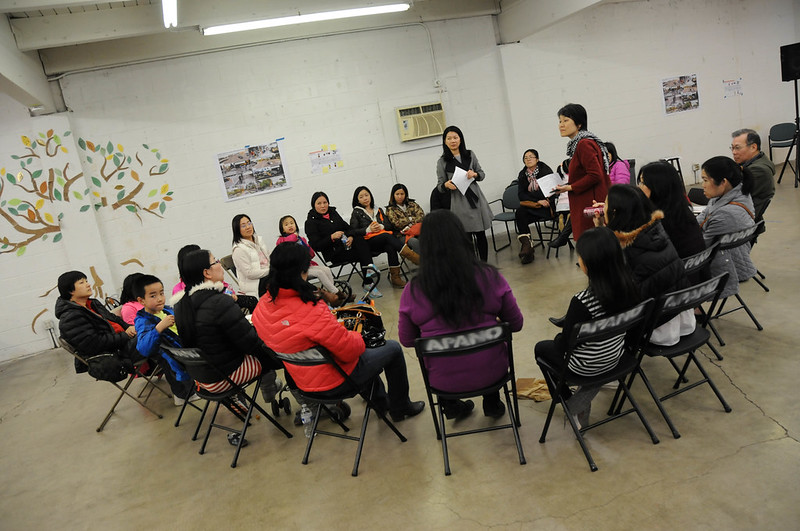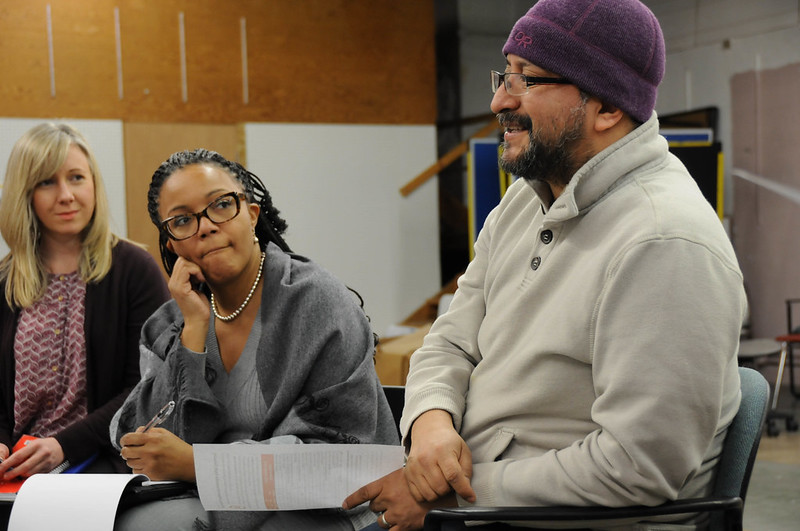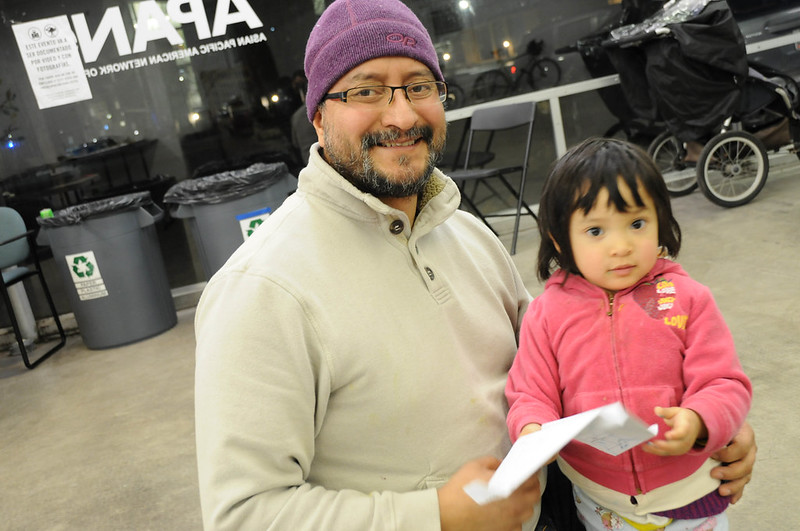Portland City Commissioner Dan Saltzman apologized to residents of the Jade District in person last night for a spate of fatal traffic crashes on outer Division Street.
Speaking as the new commissioner-in-charge of the transportation bureau, Saltzman stood in front of a mostly Chinese-speaking crowd and said, “We’re sorry and we’re bound and determined to do something about that.”
18 months ago in the exact same room as the meeting Saltzman attended last night — the Jade/APANO Multicultural Space on the corner of 82nd and Division — the City of Portland launched their Vision Zero effort. The Bureau of Transportation didn’t plan on coming back, but since that celebratory launch five people have died and three others have suffered life-altering injuries on outer Division. When two Chinese immigrants died trying to cross the street in separate collisions within just hours of each other back in December, PBOT swung into action and has been listening and formulating plans ever since.
Last night in a meeting hosted by the Asian Pacific American Network of Oregon, PBOT kicked off a community process slated to end with a plan adopted by City Council this fall.
PBOT Director Leah Treat was also in attendance last night. She looked over the crowd full of women and small children and said, “I’m struck by the many of you here with kids. I have four children of my own. I want for you to be able to walk out of this door and cross the street safely — and we need your help and ideas.”
“I want for you to be able to walk out of this door and cross the street safely — and we need your help and ideas.”
— Leah Treat, PBOT Director
Last night’s meeting was a listening session — the first step in the $300,000 outreach and education funding passed by council last month as an emergency response to December’s two fatalities. While PBOT uses their nonprofit partner APANO to organize the community and spur input from people who use Division, the City’s capital projects team has queued up a suite of projects worth about $7 million that aim to tame the dangerous arterial in a five-mile stretch from 82nd to the Portland-Gresham border at 174th.
On Vision Zero letterhead, the City passed out five-step “near-term safety strategy” for Division last night. The proposed steps include:
1) Increasing multilingual and multi-cultural traffic safety education: There’s a high percentage of non-English speakers who don’t own cars and live on and around Division. This step was requested by neighborhood groups and is spelled out in the city’s Vision Zero Action Plan. It will consist of new signage, listening sessions with city agencies, working with neighborhoods for “street team” education missions, safety messages on posters in local businesses and banners on/near the street.
2) Decreasing speed through automated enforcement: PBOT has bumped up installation of speed cameras at SE 156th by seven months and hopes to start issuing citations in a matter of weeks (instead of July).
3) Decreasing speed through speed reader boards: Plans call for four to six speed reader boards (yellow signs that read, “Your Speed XX”) spaced evenly throughout the corridor.
4) Decreasing speed through lowering posted speed: On March 2nd, PBOT will likely earn permission from Council to drop the speed limit 5 mph (from 35 to 30) for 120 days via an “emergency” declaration as outlined in a rarely-used Oregon law. In those 120 days PBOT will analyze how vehicle speeds have changed. If the plan works and speeds go down, PBOT hopes it will bolster their case to the Oregon Department of Transportation that the speed should be permanently lowered.
5) Decreasing speed through street design: PBOT will accelerate timelimes for projects already funded and planned for outer Division and will expand some other projects. Among the changes coming to the street between now and 2018 are: four rapid flashing beacons at 111th, 115th, 136th and 138th; two hybrid beacons (overhead signals that flash red when activated by a button) at 124th and 158th; improved crossings with median islands; more street lighting; completion of sidewalk gaps between 102nd and 148th; “vehicle access management” a.k.a. prohibiting certain types of dangerous turning movements; and protected bike lanes for the entire stretch.
Advertisement
As for those bike lanes, PBOT project manager Elizabeth Mahon said at last night’s meeting the plan is to create buffered bike lanes from 82nd east to the city limits. They’d be striped by 2018 and would include some sort of physical barrier between bicycle and auto traffic. Mahon said PBOT would create room for the bike lanes by removing on-street parking along Division – most of which she said won’t cause “a significant amount of congestion” because it’s currently under-utilized. Once PBOT finalizes its preferred protected bike lane treatment (flex posts are considered an interim measure), they’d go back and upgrade the buffered bike lanes.
Here’s PBOT’s list of projects and expected completion dates:
And a visual PBOT provided with what the changes might look like:
Division is currently 76-feet wide and has two standard vehicles lanes and bike lanes in both directions. So far PBOT hasn’t proposed anything that would reconfigure the standard lanes and/or reduce motor vehicle capacity. That’s a sore spot with activists from BikeLoudPDX who are fighting for changes on Division. They made their feelings known when the meeting split into two workgroups (one in Chinese, the other in English).
BikeLoudPDX Co-Chair Jessica Engelman said last night during a feedback session with PBOT (that included Commissioner Saltzman and Director Treat) that she was frustated how TriMet failed to get a dedicated bus-only lane for their upcoming Division Transit Project (largely because the agency was unwilling to create a bus-only lane). “Our conversation about capacity,” she said, “Needs to be about what kind of capacity do we really want?”. In Engelman’s view, Division needs less capacity for private car drivers and more capacity for people on foot, on bikes, in buses, and in emergency vehicles.
On the other side of the room at last night’s meeting, a workgroup of Chinese speakers who live in the Jade District shared their opinions and needs. A representative of the group said they want more streetlights to illuminate crossings, potholes to be fixed, better visibility when pulling out of driveways, and more education (and even tickets if necessary) for walkers who don’t use crosswalks.
What’s happening on outer Division matters in many ways.
This process is a test of Portland’s commitment to Vision Zero and to the people who are most vulnerable to the out-of-control driving culture on Division and the many streets like it throughout the city. We regularly fault how ODOT handles arterials — can PBOT show the state how it’s done? Will Division be a template for what PBOT can do on other arterials they might inherit from ODOT in the future?
Commissioner Saltzman also sees this process as a key organizing tool to help him pass a $2.2 million general fund budget request to fund several key elements of the Vision Zero program. During his opening remarks, Saltzman told the residents that he’s relying on them to turn out and testify. “We’re going to work hard to make this city safer for everybody, but we need your help,” he said. “I hope you’ll give us ideas about what we can we do, and I want you to know we’ll need you when we have budget hearings because we’ll be asking city council to put more money into Vision Zero and safety improvements into outer Division.”
Complicating things a bit is TriMet’s Division Transit Project. The transit agency will spend $175 million to improve bus service along Division with a scheduled completion date of 2021. PBOT’s timeline for making changes to Division doesn’t fully mesh with TriMet’s and the two agencies will have to coordinate to make sure no toes are stepped on and that changes to the street are as integrated as possible.
This project matters the most to the people who live, work, and play in the Division corridor.
Hector Dominquez spoke out repeatedly in the meeting last night. He lives nearby and walks on the street regularly. He also bikes his young daughter to school on a route that includes several stressful blocks along Division. He hopes changes will make the street safer. In the end, he said, “I just want to enjoy and be proud when I walk in my neighborhood.”
— Jonathan Maus: (503) 706-8804, @jonathan_maus on Twitter and jonathan@bikeportland.org
BikePortland is supported by the community (that means you!). Please become a subscriber or make a donation today.
